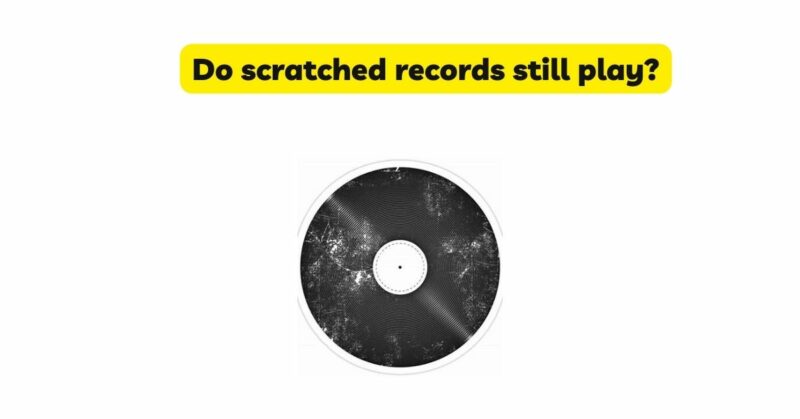Vinyl records have an undeniable charm, offering a unique audio experience and a tangible connection to music history. However, scratches on records can raise concerns about their playability and the listening experience they provide. In this article, we delve into the world of scratched vinyl records, examining their ability to still produce music despite their imperfections. By understanding the impact of scratches on record playback and exploring various factors that influence playability, we can gain insight into the enduring value of scratched records and appreciate the beauty that can still be found within these beloved musical artifacts.
I. The Impact of Scratches on Playability
Scratches on vinyl records can disrupt the playback experience in several ways. Understanding their impact is crucial for assessing the playability of scratched records. Here are some key considerations:
- Sound Distortions: Deep scratches can cause skips, pops, crackles, or repetitive loops during playback, disrupting the smooth flow of music. These distortions can affect the overall listening experience and may distract from the intended sound.
- Surface Noise: Scratches, even shallow ones, can introduce surface noise to the audio. This background noise can be heard as a constant hiss or crackle throughout the playback, diminishing the clarity and fidelity of the music.
- Tracking Issues: Scratches can interfere with the needle’s ability to track the grooves properly. This can lead to the needle jumping or skipping across the record, resulting in a fragmented and inconsistent playback.
II. Factors Affecting Playability
Several factors influence the playability of scratched records. It’s important to consider these variables to better understand how scratched records can still produce music:
- Severity and Depth of Scratches: The severity and depth of scratches play a significant role in determining playability. Superficial surface scratches are less likely to cause significant audio disturbances compared to deep gouges that can interrupt the needle’s tracking.
- Number and Placement of Scratches: Multiple scratches, especially when closely spaced or clustered, can increase the likelihood of playback issues. The needle’s ability to glide smoothly along the grooves can be affected, resulting in audible disruptions.
- Record Cleaning and Maintenance: Proper record cleaning and maintenance can mitigate the effects of scratches to some extent. Regular cleaning and removing dust and debris can help minimize surface noise and improve overall playback quality.
- Turntable Setup and Adjustment: The quality of the turntable and its setup can impact the playback of scratched records. Ensuring proper alignment, tracking force, and anti-skate adjustments can help minimize tracking errors and optimize playback performance.
- Cartridge and Stylus Quality: The quality and condition of the cartridge and stylus also influence playability. Higher-quality cartridges and styluses are designed to better track and navigate through scratches, reducing the likelihood of skipping or distortion.
III. Enhancing Playability of Scratched Records
While scratched records may pose challenges, there are measures you can take to enhance their playability and minimize the impact of scratches:
- Record Cleaning: Thoroughly cleaning records using appropriate cleaning solutions and tools can help remove dirt, dust, and debris that may exacerbate the impact of scratches. Clean records often result in improved playback, even with surface imperfections.
- Careful Handling: Proper handling and storage of records can help prevent further damage and minimize the potential for additional scratches. Always hold records by their edges and use protective sleeves to prevent unnecessary contact with abrasive surfaces.
- Tracking Adjustments: Fine-tuning the tracking force and anti-skate settings on your turntable can optimize the needle’s ability to navigate through scratches. Finding the right balance between tracking and minimizing skipping is crucial for better playability.
- Stylus Upgrades: Upgrading to a high-quality stylus designed for better tracking and performance can improve the playback of scratched records. Certain stylus profiles, such as elliptical or microline, are specifically engineered to reduce the impact of scratches.
- Digitization: If preserving the music is your primary goal, digitizing scratched records can provide an alternative listening experience. By converting the analog audio to a digital format, you can minimize the audibility of scratches and enjoy the music with reduced surface noise.
IV. The Value of Imperfection
Scratched records possess a unique charm that some audiophiles and collectors appreciate. Despite their imperfections, these records can still evoke nostalgia and hold sentimental value. They offer a genuine, authentic listening experience that cannot be replicated by digital formats. The crackles, pops, and occasional skips can become part of the character and history of the record, adding depth and personality to the music.
Conclusion
Scratched vinyl records can indeed still play music, albeit with varying degrees of distortion and surface noise. Factors such as the severity and placement of scratches, record cleaning and maintenance, turntable setup, and stylus quality influence the playability of scratched records. While deep scratches may cause significant audio disruptions, various measures can be taken to enhance playability and minimize the impact of scratches. Careful handling, proper cleaning, tracking adjustments, stylus upgrades, and digitization are some approaches that can improve the listening experience of scratched records. However, it’s important to remember that scratched records possess a certain charm and authenticity, and the imperfections they carry can add to their value for collectors and enthusiasts. Ultimately, the playability of scratched records is subjective and depends on individual preferences and tolerance for audio disturbances. Regardless of their condition, scratched records hold a unique place in the world of music, preserving the spirit of analog playback and the tangible connection to the past that vinyl records offer.


